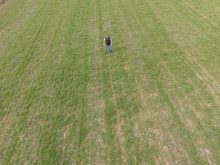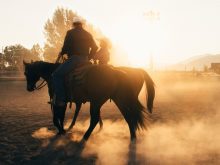A few years ago we were moving cows to a different summer pasture. It was an easy job, more of an excuse to go riding than anything. I’ve forgotten most of the details of that day.
But one moment was memorable. The cows had to walk through a little draw to get to the gate. I was sitting on my horse on one side of the draw. The truck and stock trailer sat at the bottom. I watched the cows and calves stream past the trailer, up the incline, and through the gate.
Read Also

Gentle treatments for pain in the neck
Heading toward year-end, people unknowingly tense up against the cold and busyness, causing neck pain that can often be treated with appropriate support and gentle mobility, athletic therapist Kathlyn Hossack says.
Then something strange happened. Two or three cows stopped, turned, and seemed to be staring at something, heads lowered. The trailer blocked part of my view, so I couldn’t tell what they were eyeballing.
One cow charged. For the life of me, I couldn’t understand what she was so upset about. I had the distinct impression she had a nose full of bees, the way she was snorting and smashing at the ground. Then she turned around and went through the gate.
Later I put two and two together. There was a badger den just past the gate. I think the badger was on his way home when he crossed paths with that mean old cow. I think that the cow halted her attack when the badger fled and took cover under the stock trailer.
But that’s really just a guess. I didn’t see what the cow saw. I didn’t see any injuries on the cow, either, and you’d think the badger might have got a few swipes in.
The whole situation reminds me of my job. If I was to do a proper article on the incident, I’d talk to the cow and the witnesses. Then I might try to track down the badger and see what he had to say. Or, if the cows and badger didn’t want to talk (which is quite likely), I might talk to someone with some sort of experience in badger-bovine conflicts to see if my idea held water.
If I dug into it, it’s quite likely that story wouldn’t hold up at all. I might discover a completely different reason for the cow’s distress. Or I might debunk the badger theory, but not discover the truth. Or have a strong suspicion of what really happened, but not have enough evidence to print it.
Sometimes the story just doesn’t have legs.
Hazards of the job
Speaking of job-related challenges, I think the folks at the Alberta Paramedic Association deserve a pat on the back for helping their members, and other first responders. The Association has created an online registry of psychologists who specialize in treating Post Traumatic Stress Disorder (PTSD) in first responders. You can find it at albertaparamedics.ca/resources/mental-health.
One of the psychologists listed in that registry is Dr. Meredith Evans. I’ve known Meredith for a few years (our husbands are old friends), and I knew she specialized in managing PTSD, so I wasn’t surprised to see her listed. I gave her a call to find out more about the project.
It turns out Meredith and her colleagues put together information on evidence-based PTSD treatment for the Alberta Paramedics Association. Evidence-based practices have better outcomes than other forms of treatment, she told me. Many people claim to treat PTSD, but don’t deliver evidence-based treatment, she said.
Meredith said the three main treatments for PTSD include:
- Prolonged exposure therapy
- Cognitive processing therapy
- EMDR (eye-movement desensitization and reprocessing)
That list isn’t exhaustive, she noted. But all three of those treatments have an “exposure component.”
“Avoidance maintains PTSD and exposure treats PTSD,” she said. When she explains the process to people, they say it sounds like she’s asking them to face their fears. You can think about it that way, she said, although it’s more complicated.
Paramedics and other first responders face some big challenges when it comes to dealing with trauma. The biggest thing that sets first responders apart from most people is the “repeated exposure to traumatic events,” said Meredith. Encountering traumatic situations over and over can have a cumulative effect. “That puts them at a higher risk for developing PTSD.”
Paramedics do have critical incident stress debriefings, which are a way to check in and deal with a traumatic event right after it’s happened. But those debriefings are done in group sessions, Meredith said, and it’s not a culture that encourages people to step forward with mental health issues.
As part of the “soldier on” mentality, first responders tend to use a lot of black humour to cope, Meredith said. People can misinterpret black humour to mean someone is cold and uncaring. But first responders suffering from PTSD tend to use it to keep an emotional distance, Meredith said.
First responders in rural and remote communities have an even bigger barrier finding specialized help. Meredith told me there are only a few psychologists in Edmonton who specialize in PTSD, so finding someone in a smaller centre is unlikely. “I have people driving three hours each way to come see me.”
The RCMP has a good system, sending their police officers to specialists like Meredith. But if they’re in a remote location, getting them into the city is a challenge. And Meredith told me she thinks about fire fighters in small communities who don’t have access to those resources.
People who are worried about a friend or family member who’s been exposed to trauma can watch for signs of PTSD. They include:
- Withdrawing from friends and family;
- Drinking more;
- Avoidance (for example, avoiding things that might trigger memories of the event);
- Depression (it typically goes along with PTSD); and,
- Anger and irritability
Video teleconferencing or phone sessions are an option for rural first responders. But there are problems and risks when the therapist isn’t there with them.
“What if they get really upset and take off? You can’t follow them,” said Meredith. Although she has mixed feelings about sessions, she did say they might be part of the solution.
In remote areas, Meredith said she would have a PTSD-sufferer go to any mental health worker, even if they don’t use evidence-based treatment for PTSD. Some people probably do improve even if their therapists don’t specialize in PTSD, she said.
“A lot of treatment and recovery is the relationship with the therapist.”
Ultimately, getting resources to rural first responders strikes me as another one of those “wicked problems”–complex, involving many stakeholders, and with no easy answer. But groups such as the Alberta Paramedic Association should be commended for taking practical steps to help both urban and rural first responders. Sometimes progress is measured in inches rather than miles.
For more information on PTSD, visit ptsd.va.gov.















